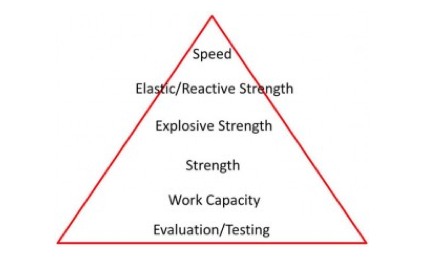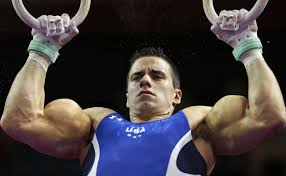![]()
The novel coronavirus brought normal training to a halt for many. While those with garage gyms flourish, those who had come to rely on commercial gyms and high-performance facilities languish. How are we to go on?
First, to check my own privilege: I’m writing to those who are fortunate enough to be safe and to have an abundance of time in quarantine. We should recognize that this is a luxury that is not shared by our society’s essential workers. Or, perhaps some of you are parents of young children, and/or working from home full time. My purpose is to provide some insights for those that are able to spend more time and effort than usual focusing on their health and fitness at this time, never to pressure or shame those who cannot or choose not to do so.
Too Long, Didn’t Read: Now is a great time to focus your training on yoga for flexibility, high-rep calisthenics for hypertrophy, and running for endurance, while focusing your nutrition on gaining or losing weight according to your goals…but I doubt this brief suggestion will be sufficiently convincing, so continue reading to get my full train of thought.
We’ve all been thinking about the 90s Chicago Bulls a lot lately, as ESPN releases “The Last Dance.” Strength-coach-Twitter has been abuzz as we all try to catch a cameo of Al Vermeil in the background. Al Vermeil was the strength coach for the 90s Chicago Bulls, as well as the 80s San Francisco 49’ers. Al is regarded as an absolute authority on athletic development, and formed a now-famous hierarchical model to communicate priorities to coaches and athletes. In short, the lower stages of athleticism potentiate the higher stages (this follows similar concepts of phase potentiation and block periodization by Tudor Bompa and Vladimir Issurin).

Al Vermeil’s Hierarchy of Athletic Development
What does this mean? It means that if 100% of your training time is focused on maximal speed, you’ll improve your speed a bit, but then you may plateau hard. If you focus 100% of your training time on maximal strength (maxing out constantly), you’ll improve your strength a bit, and then plateau hard (we all know this guy). But if you spend a good amount of time improving less intense efforts (higher rep ranges with lighter weights, greater distances at a slower pace), it’ll set you up for greater success next time you train for maximal strength or maximal speed.

Brad deWeese phase potentiation for the enhancement of speed
It’s debated as to whether your training needs to be specifically sequenced in this manner, but most coaches agree that training should be composed predominantly of a greater quantity of less-intense efforts in order to build the body towards less-frequent, more-intense efforts. Our cross-country coach, Sean McCafferty, recently directed me a researcher, Stephen Seiler, whose work serves as further evidence of these principles. In short, the greatest endurance athletes in the world spend 80% of their training sessions at low intensity, and only 20% of their sessions at higher intensities. It’s interesting to me that these principles apply similarly to top athletes in endurance events as they do to top athletes in power events.
To that end, top Olympic competitors in power sports like weightlifting are known to take time after each quadrennial competition cycle to focus on aerobic training (especially swimming), which they find to be far less taxing on their bodies, allowing them to heal from the trauma of the intense efforts of their sport, and set them up to have the stamina to train hard and long in the coming months and years in preparation for the next Games.
The lowest stage identified by Vermeil includes Evaluation & Testing, in which he ensured that his athletes were ready to train. Remember, he’s dealing with multi-million dollar athletes here; he can’t let them get hurt because they weren’t flexible, coordinated, and stable enough to train squats and deadlifts! Athletes in this stage should focus on mobility and postural integrity, implementing training modalities like yoga (I tried to find the clip in Episode 3 where the Bulls literally have yoga mats on the basketball court…if you find it, let me know the timestamp) and isometrics for core stability (eg. plank holds and back extension holds). If find yourself often injured or dealing with pain, now is a great time to allow those injuries to heal while focusing on improving your readiness to train in the future. Perhaps you are here.

Al Vermeil told me he never let any of his athletes snatch, clean, squat, or deadlift if they couldn’t hold a back extension for 3 minutes. That’s what we mean by evaluating postural integrity.
After this comes Work Capacity, which includes a great deal: Aerobic Conditioning (what the general public would refer to as “cardio”); Anaerobic Conditioning (recovering from more intense efforts, often with minimal rest; think of Tabata protocols and High-Intensity Interval Training), Hypertrophy (Bodybuilding…need I say more?), and generally improving body composition (losing fat, gaining muscle; the kind of stuff that you’d expect to be the outcome of these sorts of training regimens). If you’re like me, you are here.
I’m actually going to stop there, because the rest has been covered before, and won’t be our emphasis today. You are here. You can’t train maximal strength, but you can train just about everything else.
If your only goal is maximal strength, now is a great time to actually dedicate time to the flexibility and mobility work you’ve been neglecting for – admit it – years. Many strength-focused athletes won’t know where to start, but fortunately there are countless YouTube yoga videos and apps for that.

Plenty of Weightlifters like Mattie Rogers make use of ROMWOD and similar yoga apps for warmups, cool-downs, and recovery sessions to improve mobility and flexibility.
Maybe you could stand to lose a few pounds; now is a great time to focus on that as well. Download a guided run app (I’ve been using the Nike Run Club app) and start knocking out some miles. Download a nutrition tracking app (I’ve used MyFitnessPal) to hold you accountable to protein-rich diet at a caloric deficit. Don’t worry too much about “losing muscle,” because your muscle cells will retain most of the nuclei they’ve gained, and you’ll gain back what little muscle you scare yourself into thinking you’ve lost as soon as you are able to return to your regular training. Plus, you’ll look and feel a lot better, and probably be able to train harder than you could before, because you’ll dissipate heat more quickly and recover faster within and between sessions.

Myonuclei acquired by overload exercise precede hypertrophy and are not lost on detraining
Maybe you could stand to gain a few pounds! Just about everyone from skinny beginners to experienced bodybuilders can get decent results from high-rep bodyweight exercises like pushups, pullups, Bulgarian split squats, and Cossack squats, while eating a protein-rich diet at a caloric surplus. Download a bodyweight tracking app and weigh in regularly to make sure that number climbs at about 0.5-1% increase per week (1-2 lb gain for a 200 lb athlete) for up to 12 weeks.

- Gymnast Jake Dalton can tell you that bodyweight training can help you get jacked.
For now, you are here. The barbell will be there for you when you get back, unchanged, but you’re unlikely to be exactly the same as you were when you left it. My hope is that when you return, you are leaner, fitter, more flexible than you were pre-quarantine, and ready to ease back into the long climb of personal records. And then, we’ll go from there.
To hold myself accountable: I hope to write my next article on how to return to training after an extended period of disruption. Stay tuned.